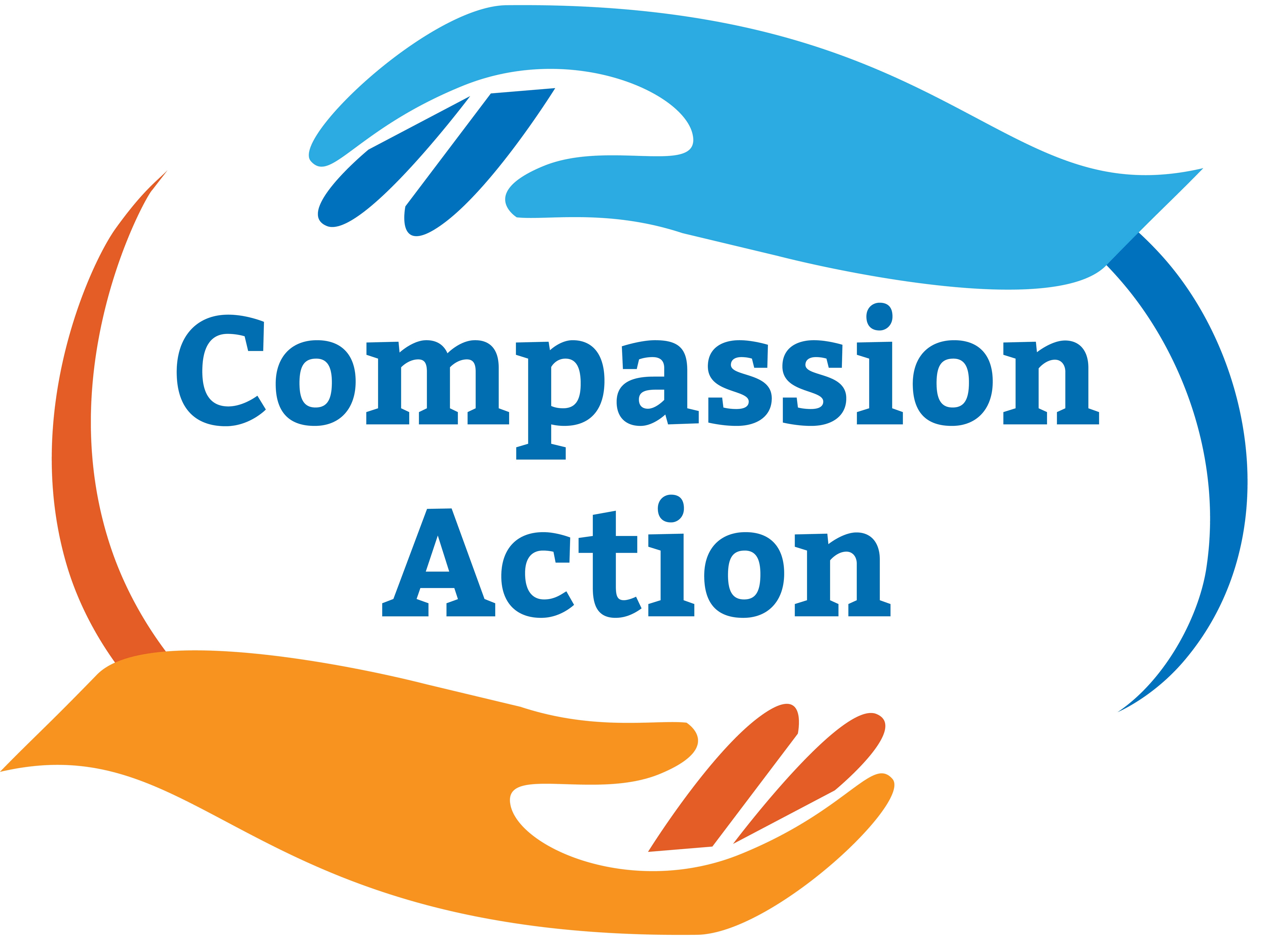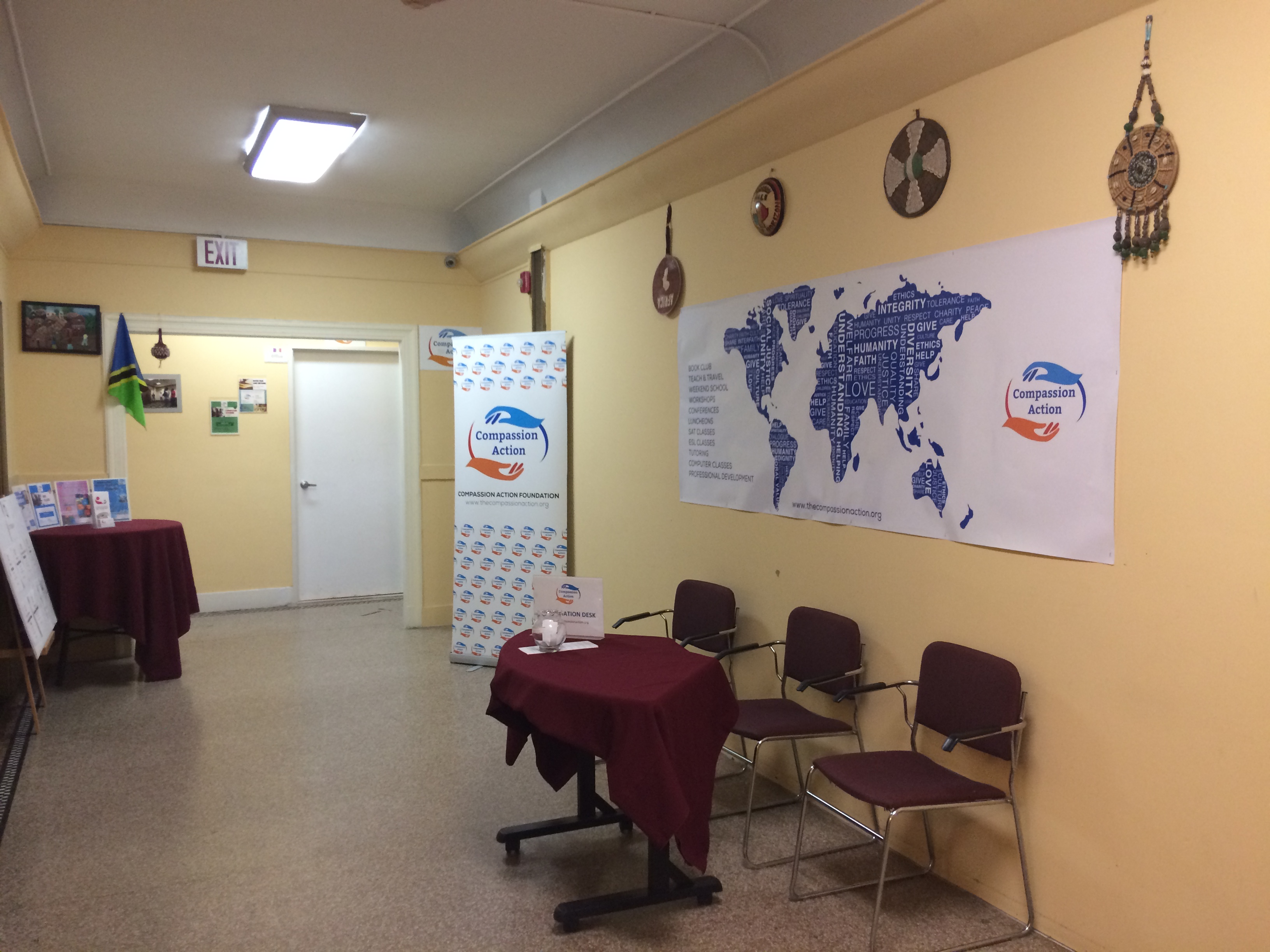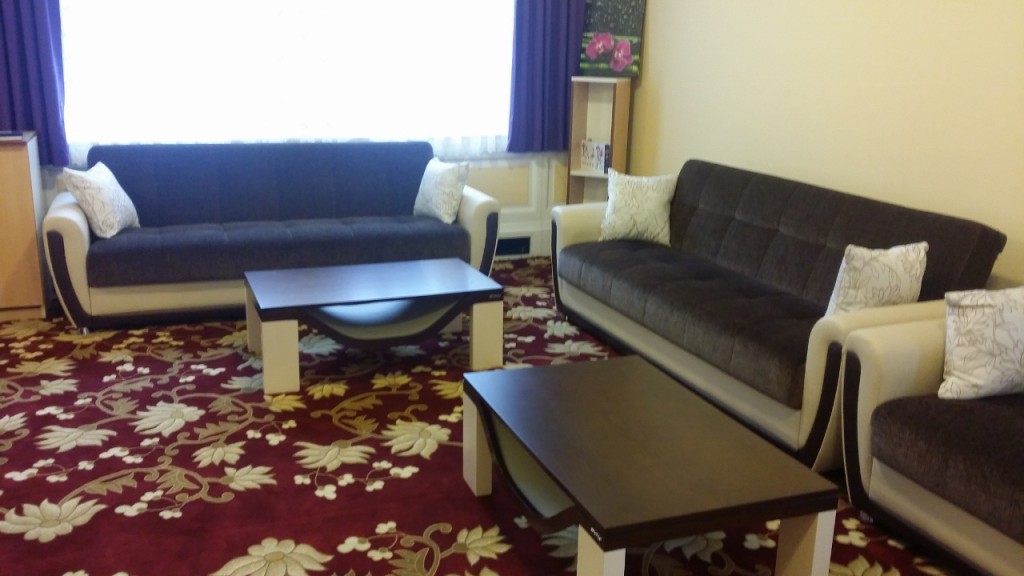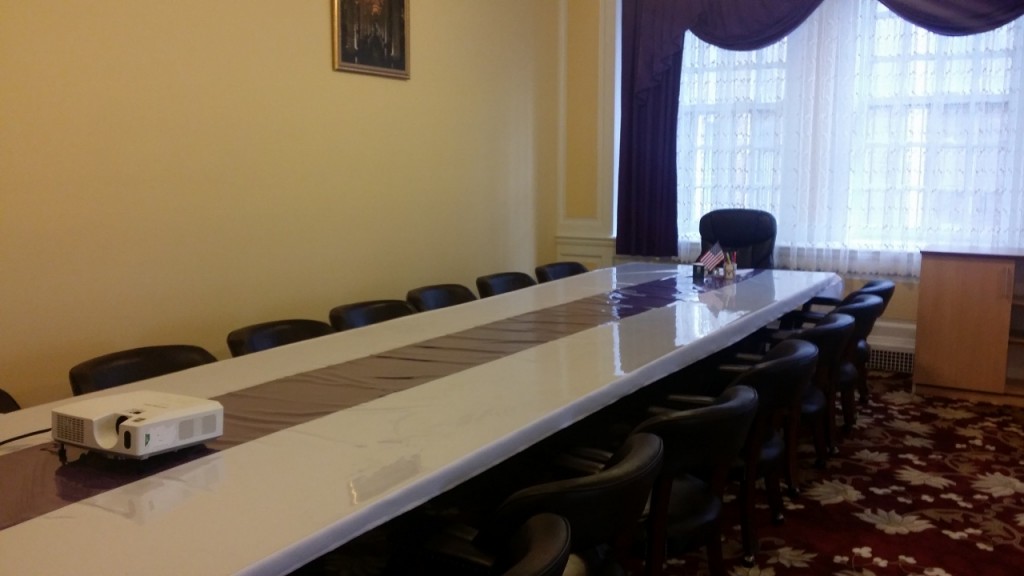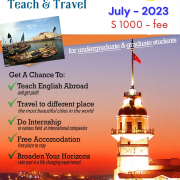HEALTHY COMMUNITY
/in Uncategorized /by compassionThe Compassion Action is very much concerned about the health of the community. Health is a very important issue, nowadays, because of the quantity and variety of diseases that often go undetected which results in the loss of human life. In a modest attempt to preserve humanity, we wish to begin a project which offers free dental and doctoral check-ups to families in our communities. We cannot do it alone. We will need generous doctors and dentists to volunteer their services for our community. We will need a community who is willing to benefit from these generous doctors and dentists. Together, we will build a healthy community!
FEEDING THE NEEDY
/in Uncategorized /by compassionThe Compassion Action’s vision is to create a better community for the next generations. In order to do so, we must always remember to keep those who are less fortunate and needy in mind. On top of providing the community’s hungry and homeless with meals on a regular basis, the Compassion Action will also be carrying two projects to provide food for those in need.
CLOTHING DRIVE
/in Uncategorized /by compassionIt’s that time of year again to give thanks for and appreciate all of the things we have. What better way to give thanks than by giving to those less fortunate than you? Join the Compassion Action this month in distributing clothes to the needy. Not only can your donations keep many warm, but you will also be giving someone a reason to be thankful.
SCHOLARSHIP
/in Uncategorized /by compassionImportant Dates
Application Deadline : May 1,
Interview : May 18 – May 30,
Scholarship Starts : October 1,
Scholarship Ends : May 1,
Links
COLLEGE COUNSELING
/in Uncategorized /by compassionA college education is one of the largest and most important investments people ever make for themselves. The college admissions process can be, and indeed should be, a rewarding, stimulating, and successful experience for you, not a burdensome task to be undertaken with anxiety. It can be fun, and it will inevitably be a time for self-discovery and self-knowledge. You are heading into a venture in which you will learn much about yourself, your feelings about education and your place in an educational environment, and about your place in life and what you want from it and are willing to give to it. Compassion Action is available to assist students during this process in any way possible.
MENTORING
/in Uncategorized /by compassionAt its most basic level, mentoring helps because it guarantees a young person that there is someone who cares about them. A child is not alone in dealing with day-to-day challenges. Mentors provide their mentees with an experienced friend who is there to help in any number of situations. At Compassion in Action, our number one priority is the student. Our mentors provide support for education related issues, daily living, and workplace problems.
TUTORING
/in Uncategorized /by compassionWith classroom sizes in inner cities growing at rapid rates, students are getting less and less personal attention from teachers. Personal attention is vital for academic improvement and success. Here at Compassion Action, we believe in tending to students’ each and every academic need. Thus, we provide private tutoring to students age 6-18, from Monday-Saturday. Tutoring on weekdays is by appointment only, and tutoring on Saturdays is from 9am – 2:30pm
TEACH AND TRAVEL ABROAD– SUMMER
/in Uncategorized /by compassion
Important notice: Updated dates and the country list will be published soon for the 2021 teach and travel abroad summer.
Introduction and Mission Statement
Compassion Action supports Teach & Travel program. Teach and Travel is an international project, whose aim is to place participants in different countries all over the world. Our volunteers, who were either graduates or undergraduate college students from the USA taught ESL to students ranging from elementary school to high school during their summer vacation. It was wonderful to see them gain a new and rewarding experience, abroad nonetheless, while at the same time feel excited about showing their teaching abilities. They had the opportunity to make very close friendships and get to know different people and cultures. In fact, CAF volunteers should be recognized for the good impressions they left to the principals, students and parents as well. The Teach &Travel program took place in 3 to 4 weeks of teaching and 3 days of travelling in some of the most prominent touristic locations around Tanzania . It is important to mention that the “Travel” part was just as exciting as the “Teaching” part. Traveling to amazing historical and touristic locations, participating in interesting regional activities, tasting different kinds of dishes from other cultures and being hosted by local families were some of the common activities taking place in this program. Beyond traveling, it was a fun and entertaining experience as well. It is obvious that CAF volunteers who participated in this project are looking forward to being more involved in future CAF programs.
—————————————-
More Details
- Teaching
Tanzania
Date : July 2023
Mission
The Teach & Travel Program’s mission is to bring students of different cultures and backgrounds together to understand one another, network, enrich their resumes, develop leadership and build self confidence.
Program Description
Teach & Travel is a 3 or 4 weeks program designed to teach English as a second language to elementary, middle or high school students. The Teach & Travel (T&T) program is an international project aiming to place participants in different countries , giving an excellent opportunity to gain valuable international experience. Teaching positions will be available in many countries. Each Teach & Travel region in North America goes to a specific country. Please see the chart below for the destination countries.
The program is focused on teaching through speaking. A unique activity oriented, speaking focused summer program curriculum along with books and supportive documents prepared by the education department of CAF is used in the program. The material is delivered through a facilitate learning methodology. The program is implemented mainly in two type of settings:
- Traditional Teaching Environment: Most schools follow an ESL curriculum throughout the year. Students have their regular ESL teachers as supervisors of the summer program.
- Non-traditional Teaching Environment: This option is preferred mostly by non-educational institutions; examples include municipalities, professional associations and similar organizations.
Training Process
Participants are required to complete the mandatory Teach & Travel training sessions. Training sessions cover topics like class management, orientation on student profile, training for teaching materials and activities, sample class sessions and more. Regional offices offer training sessions locally and online training option is NOT available.
- International Summer Internship (Optional)
Mission
The internship program gives participants to gain valuable experience, enrich their resumes and build professional networks.
Program Description
The internship program is a 2 to 4 week internship program available in fields of Business & Finance, Media and Journalism, Security/Criminal Justice & Governance, Health & Medicine, Education, NGO, and Architecture. Interns are unpaid. The internships are full-time (40 hours per week). Participants may receive university credit for their participation, depending on their school’s credit policy. There are mainly two types of internships:
This internship is a classical internship format in which for three weeks, participants are assigned to one institution. In that period, candidates are introduced to the company, systems and are assigned tasks and projects. Media and Journalism, Health & Medicine, Education, and Architecture internships are all in regular internship format.
- Travel
Mission
The aim of the travel portion of Teach & Travel is to afford an opportunity to learn about different cultures and history of locals. The trip portion of the program is not necessarily continuous (consecutive days). It may consist of several outings, i.e., festivals, cultural events, tours, and celebrations according to the placement of participants. This trip will include visits to historic sites, tourist attractions and civic institutions. Participants can also have the opportunity to gain college credit from their educational institutions by creating a portfolio of their experiences in the form of a written or visual journal.
Program Description
The trips are designed by your regional coordinator. Please contact your regional coordinator for the cost of the travel and its itineraries. Please note that the travel portion is not included in the overall cost of the program.
————————————
Logistics
Airport pickup
Airport pickup in destinations will be arranged only for the participants who arrive within the designated pickup dates in the program schedule. Group shuttle pickup dates and hours will be announced.
Sightseeing Tour/s
Sightseeing tours are offered for all Teach & Travel participants. They are not mandatory. They are NOT sponsored. This trip/s will include visits to historic sites, tourist attractions and civic institutions. The sightseeing tour/s destinations and itinerary will differ according to the teaching and internship locations of the participants.
Transportation
Participants are required to purchase their own tickets. Transportation within the summer program is the sole responsibility of the participant. Some local hosting institutions may provide complimentary transportation service.
Housing
Accommodation will be provided by the institution.
- Housing Facilities are not “co-ed”.
- Alcohol and smoking are prohibited.
- There is a strict “no guest” policy.
- Facilities are either college dorms or student housing. In some exceptional cases, host families may offer accommodation.
- Participants are responsible for upholding the existing rules of the housing facility, which may differ.
- The institution is responsible to make sure the basic housing conditions promised by them are met in every location which doesn’t include:
- internet availability
- private room
- free meal
** In some locations, participants may be offered these kinds of ‘extra’ services as a courtesy by their education institution.
Food
Participants are responsible for their food costs.
Visa
All visa requirements are the sole responsibility of the applicant.
Insurance
Participants are required to have traveler’s insurance. Our institution is not responsible for any kind of loss or medical expense of the participants.
————————————————–
Program cost
- Application Fee
Each participant is required to pay a $100 application fee.
- Program Fee
Each participant is required to pay a $1000 program fee after getting accepted to the program.
The program price does not cover only the costs directly linked to your presence on the ground. It also shares other costs required to give you the best experience.
Program Fee Includes:
- Accommodation (Accommodation may or may not include food nor Wi-Fi)
- Pre-departure support from Regional Coordinator by email, phone and in person.
- In country support by local coordinator.
- Training’s
- Transportation
- Airport Pickup and Drop Off in destination countries.
- Transportation to destination city of teaching.
- Transportation to destination city of internship.
- The following transportation is NOT covered:
- Any kind of travel, leisure or sightseeing transportation.
- Local transportation to and from your internship location.
- The flight tickets to the destination countries, and in between cities.
————————————————
Eligibility for Scholarship
Each institution has its own eligibility requirements. But the general guideline is as in the following description.
- Applicants must be of specified ethnically background by the institutions.
- Applicants must be a US Citizen or Permanent Resident.
- Applicants must be a recent High School graduate or a current college student.
- Applicants must show active presence in one of the following Community Service programs provided by the relevant institution. The amount of funding is as specified in the “Meeting the Requirements” section:
- Education Services Programs:
- After School
- Weekend School
- SAT/ACT Program
- Community Service Projects. For detail please contact your regional coordinator.
- Education Services Programs:
- Applicants must provide official documents proving their financial income. The amount of funding is as specified in the “Meeting the Requirements” section.
Applicants who meet these criteria have the chance to win the following funding that applies to their Teach & Travel program price.
You can apply for the Teach & Travel Fund on your program application.
Education Services Requirement
The applicant may receive a scholarship fund between $250 – $500. This fund is only applicable for the Teach & Travel program fee.
Applicant must actively volunteer at one of the of the following programs at least once a week for 10 times.
- After School
- Weekend School
- SAT Program
Community Services Requirement
Applicant may receive a scholarship fund between $250 – $500. This fund is only applicable for the Teach & Travel program fee.
Applicant must show active participation one of the available projects that is provided by the institution. For detail please contact your Teach & Travel regional coordinator.
Financial Aid Requirement
Applicant may receive a scholarship fund between $250 – $500. This fund is only applicable for the Teach & Travel program fee.
Applicant must submit official documents.
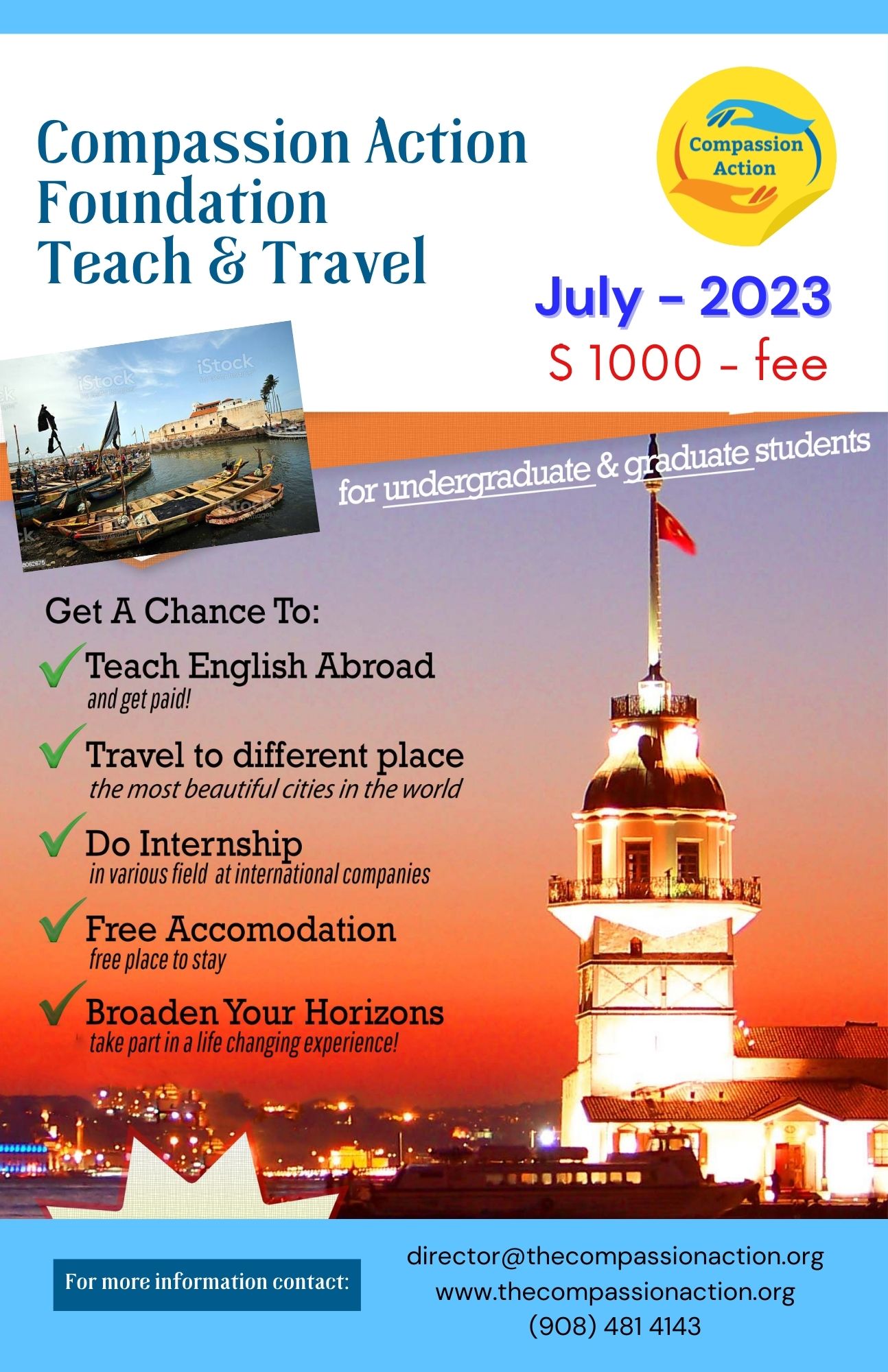
SAT PREPARATION
/in Uncategorized /by compassionAbout the SAT
- The SAT measures what you know and how well you apply that knowledge.
- The SAT is a primary factor in college admission.
- It tests the same things taught every day in high school classrooms — reading, writing and math.
- Although high school grades are a very useful indicator of how students will perform in college, there is great variation in grading standards and course rigor within and across high schools.
- Educators trust the SAT as a useful part of the college application process because the SAT is:
- The most widely used standardized admission test (college entrance exam).
- The most researched and tested standardized admission test
- Almost all colleges and universities use the SAT to make admission decisions.
- A combination of grades and SAT scores is the best predictor of a student’s future success in college.
- The standard in reliability and validity
- An internationally recognized, accurate measure of college readiness and scholarship potential
Why Take the SAT?
As the nation’s most widely used college admission test, the SAT is the first step toward higher education for students of all backgrounds. It’s taken by more than two million students every year and is accepted by virtually all colleges and universities.
There are many reasons to take the SAT, but here are a few of the biggies:
It tests what you already know
The SAT tests the reading, writing and math skills that you learn in school and that are critical for success in college and beyond.
It gives both you and colleges a sense of how you’ll be able to apply the thinking, writing and study skills required for college course work.
It’s fair to everyone
The questions are rigorously researched and tested to make sure students from all backgrounds have an equal chance to do well.
And the test is straightforward. There are no tricks designed to trip you up. Students who do well in the classroom are often the same ones who will do well on the SAT.
It’s more than just a test
The SAT also provides the opportunity for you to connect to scholarship opportunities, place out of certain college courses and learn more about your academic strengths.
It helps you select the right fit for college
SAT scores are among the factors considered in college admission. Many schools’ websites share the range of SAT scores reported by their admitted students.
Rise to the challenge
The 21st century global economy is fast-paced and changeable. You’ll need a new set of skills – and a habit of lifelong learning – to flourish in this information age. The best way to succeed and thrive as an adult is to challenge yourself to rise to a high level of academic excellence now. You’ll do that best by taking challenging high school courses and working hard in them.
The SAT provides a trusted, nationally recognized indicator of your academic readiness for college. In a way, the SAT is the bridge between the hard work you’ve already done and the college that is the best fit for the future you are about to create.
Test Details
- Three sections: critical reading, mathematics and writing
- Length: 3 hours, 45 minutes (including three breaks)
- Score range: 200–800 per section, 600–2400 overall
SAT Question Types
The SAT contains several different question types, including a student-produced essay, multiple-choice questions and student-produced responses (grid-ins).
- Critical Reading
- Reading comprehension
- Sentence completions
- Paragraph-length critical reading
- Mathematics
- Numbers and operations
- Algebra and functions
- Geometry
- Statistics, probability and data analysis
- Writing
- Improving Grammar and Usage
- Identifying Errors
- Word choice
- Student-written essay
| What’s on the SAT | |
| Total Time | 3 hours 45 minutes |
| Critical Reading | Sentence completions (19) |
| Passage-based reading (48) | |
| Two 25-minute multiple-choice sections | |
| One 20-minute multiple-choice section | |
| Mathematics | Multiple choice (44) |
| Student-produced responses (10) | |
| Two 25-minute sections | |
| One 20-minute section | |
| The 54 questions cover: | |
| Number & operations (11-13) | |
| Algebra & functions, including higher-level math (19-21) | |
| Geometry & measurement (14-16) | |
| Data analysis, statistics, & probability (6-7) | |
| Writing | Identifying sentence errors (18) |
| Improving sentences (25) | |
| Improving paragraphs (6) | |
| Essay (1) | |
| One 25-minute multiple-choice section | |
| One 10-minute multiple-choice section | |
| One 25-minute essay | |
| AdditionalUnscored Section | One 25-minute section (not the essay) |
- Test Order
The SAT is composed of 10 testing sections. The first section is always a 25-minute essay, and the last section is always a 10-minute, multiple-choice writing section. Sections two through seven are 25-minute sections. Sections eight and nine are 20-minute sections.
- The Unscored Section
In addition to the nine scored sections of the SAT, there is one 25-minute section that the College Board uses to ensure that the SAT continues to be a fair and valid test. It may be a critical reading, mathematics or multiple-choice writing section. Your performance in this section does not count toward your score, and you will not be able to tell which section is unscored while you are taking the test.
When to Take the SAT
Most students take the SAT during their junior and senior year in high school, and that’s what is typically recommended.
At least half of all students take the SAT twice usually once in the spring of their junior year and again in the fall of their senior year. Most students improve their scores the second time around. This is partly due to covering more academic material from junior to senior year.
Getting Ready for the SAT
- Select challenging high school courses. The best way to get ready for the test is to do well in school, study hard and become familiar with the test and the testing environment. There are no tricks or shortcuts to improving your performance.
- Read widely and write extensively, both in and out of school.
- Take the PSAT/NMSQT® as a sophomore or junior.
- Become familiar with SAT question types, format and directions. SAT practice in a school or home setting can help you familiarize yourself with the test and the test-taking environment.
A Little Practice Goes a Long Way
- To feel comfortable and confident on test day, it’s a good idea to be familiar with the test format and question types.
- Like anything else in life, a little practice never hurts.
- In sports, a warm-up round or scrimmage match is always a good way to prepare for the real game.
Support
Compassion Action Foundation INC. CAF is a 501c(3) Tax-Exempt Non-Profit Organization
NEWS
CONTACT
Office Address: 271 Route 46 West Suite F-204 Fairfield, NJ 07004
Phone: +1 (908) 481-4143
Email: director@thecompassionaction.org